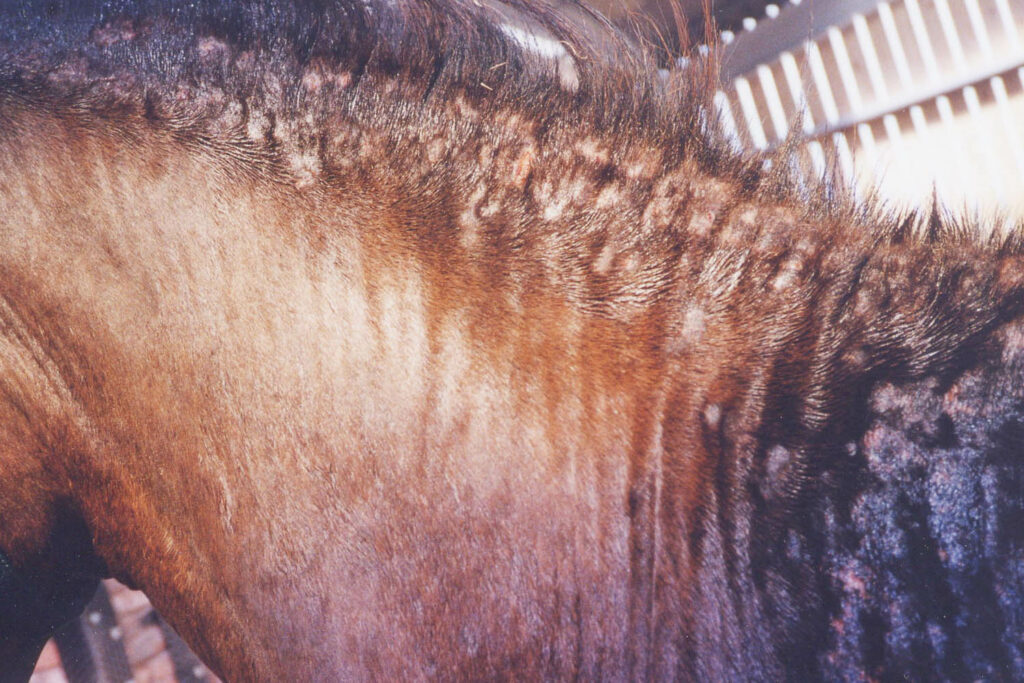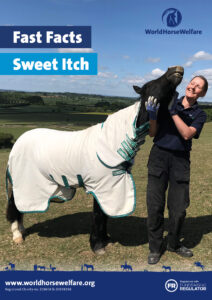What is sweet itch?
Sweet itch is an allergic reaction to bites from mosquitos, flies (e.g. Simulium, black fly) and midges (e.g. Culicoides) which can affect almost any horse or pony – regardless of type, breed and age – but research does show it is particularly prevalent in some native breeds. Sweet itch is the most common allergic skin disease in the UK and affects around 5% of our horse population.
The term ‘sweet itch’ literally describes the sensation experienced by the horse in reaction to the bites, it can also be referred to as ‘pruritis’. The condition varies in severity from the horse occasionally scratching their tail on a tree to the very worst cases who will scratch and scratch, causing self-trauma, which in turn can lead to secondary infections.
How to spot sweet itch in horses
Early diagnosis and treatment of sweet itch will give you a much better chance of being able to manage it effectively. If notice your horse or pony scratching, the first thing is to ascertain whether they are actually suffering from sweet itch. There are many other allergens with the same or very similar clinical signs as sweet itch but may not be caused by midges.

What are the symptoms of sweet itch?
Symptoms of sweet itch will vary widely from horse to horse. Some will be severely affected by just one or two bites, whilst others may experience no reaction at all.
- Itching will often be focused on the neck, mane and tail, but these areas are not exclusive, and the worst affected horses may end up rubbing and biting at their skin wherever they can reach.
- Affected areas will appear lumpy or scaly and usually inflamed or hot to the touch, but you may also just notice areas where the hair appears ruffled and rubbed.
- Self-trauma from scratching may cause hair loss, bleeding and thickening of the skin.
- Skin may also look scurfy or dull in patches, although it is a symptom which could indicate a different condition.
- Some horses can become restless and in the very worst cases may even start to lose weight because of the condition.
- Grooming your horse regularly is a good way to keep a close eye on their skin so you can recognise any changes and take appropriate action quickly.
To diagnose sweet itch, your vet may want to do intradermal allergy testing. This test will inject midge extracts into the skin to observe for a reaction. This will also detect for other allergens so you can narrow down the potential causes.
When should you be most vigilant for symptoms?
The mosquitos and midges which cause sweet itch are usually active from spring to autumn, however this is not the only time when symptoms may show. Typically, sweet itch will be a seasonal condition, but it is common for affected horses to show increasingly severe symptoms over time, and some will experience problems all year round.
What steps can be taken to prevent sweet itch?
When it comes to sweet itch, prevention really is much better than cure and one of the worst things you can do is ignore the early signs.
- Invest in a good quality full body fly rug, and ensure you purchase at least one spare on so you can wash and rotate the rugs.
- Choose a suitable fly repellent. Those with pyrethroid or permethrin-based ingredients are often the most effective. DEET is effective but can cause soreness in some horses so test on a small area before applying to the whole body. You can also purchase insect repellent suitable for stables and field shelters.
- Biting insects tend to be most active at dawn and early evening so, if possible, try to keep your horse stabled, provide access to a field shelter or ensure they are in a suitable fly rug during these times.
- You can by special mesh to cover stable doors and window which can reduce or eliminate flies and midges coming into contact with your horse. Introduce this to the horse slowly, especially if it may affect their ability to see other horses whilst stabled.
- Avoid water-logged areas or soft mud wherever possible, as this is where midges like to lay their eggs.
- Areas that are naturally windswept will have a reduced midge population than sheltered locations where the air is very still. Assess your paddock and fence of any unsuitable areas.
How can sweet itch be treated or managed?
Unfortunately, there is no real cure for sweet itch, and management can take some trial and error to determine which strategies work best for your horse.
- Steroids can offer relief from the clinical signs (skin irritation and itching) in the short to medium term. However, over the long-term steroids increase the risk of laminitis so this is not a sustainable solution and must only be used if prescribed by your vet.
- Antihistamines may help relieve the symptoms but must be administered in relatively high quantities. Once again, these should only be used if advised by your vet.
- Anti-itch shampoos can be effective to help reduce itching – look for those which contain oatmeal, antihistamines or local anaesthetics. Cold water or ice can provide immediate, short term relief.
- Research has shown supplements containing omega 6/3 fatty acids, such as flax seed or evening primrose oil can be effective in reducing itching. Cavalesse is a supplement containing Nicotinamide has been shown to be partially effective in relieving clinical signs.
Different solutions and products will work for different horses so there will be some trial and error to find what is effective for your horse and your situation. A combination of preventative measures and taking appropriate action/treatment as soon as any signs develop will help to manage the problem and make life as comfortable for the affected horse as possible.
For more information, you can contact the sweet itch advice line run by Itchy Horse.
Fast Facts guide to Sweet itch

This Fast Facts guide includes:
- Causes of sweet itch
- Clinical signs and treatment of sweet itch
- Risk factors and prevention strategies
Popular advice in Health

Mites: how to treat them in horses
Find out how our experienced teams tackle this itchy problem in affected horses and ponies.
Other advice categories
All webinar categories:
Call our Advice Line
+44 (0)1953 497 238Not found the advice or answer you were looking for here? Then our Advice Line is available during office hours, or you can email us on education@worldhorsewelfare.org to let us know what topics you were looking for.



